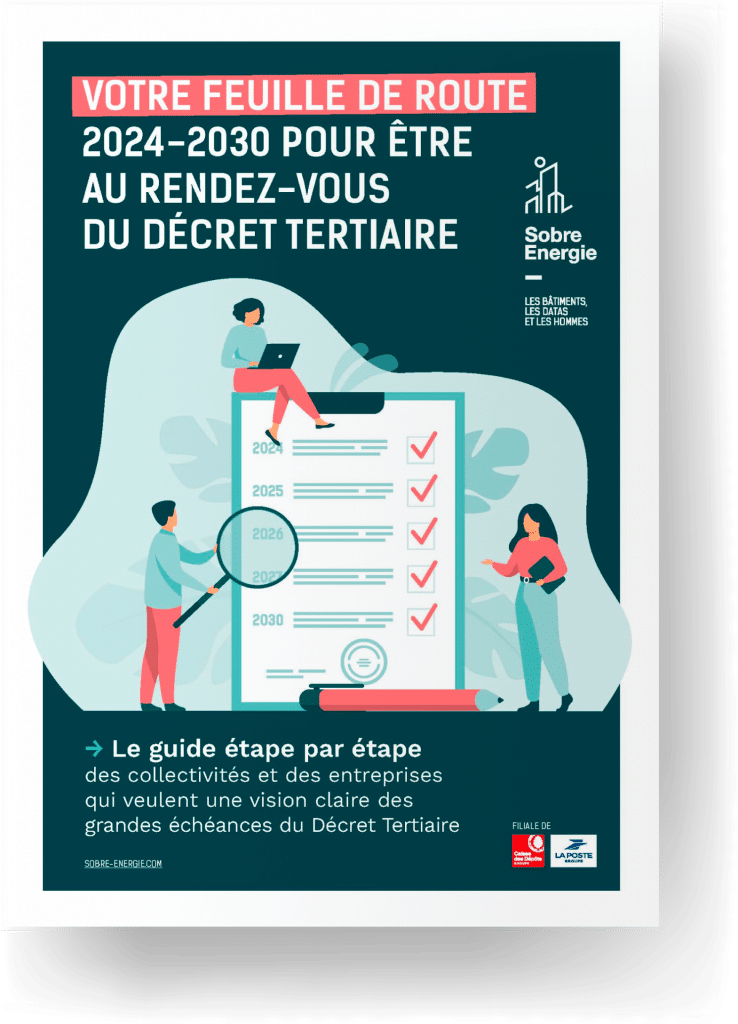The new deadline for declaring consumption data on 09/30/2023 on the Ademe OPERAT platform has now passed. Now time for the implementation of a consumption reduction trajectory for subject sites.
How to set your strategy for this second phase? What tools can help you achieve your goals for 2030, 2040 and 2050?
Here are the 4 steps to follow with our Tertiary Decree experts at Sobre Energie
What are the objectives of the tertiary decree?
As a reminder, the Tertiary Eco Energy System (DEET), better known as the Tertiary Decree, requires subject tertiary buildings to reduce their consumption by 2030 and ultimately 2050. The objective to be achieved, depending on the category of buildings, is fixed in two ways:
- in relative value for example -40% by 2030 compared to the consumption of the reference year
- in absolute value for example
Each year, an owner or tenant must declare their consumption on the OPERAT platform. Ademe will thus evaluate the consumption reduction trajectory according to the assigned objectives.
Learn more about the Operat declaration
How to respect the tertiary decree?
- 1st : centralize the management of its buildings on an energy monitoring tool.
Our SAAS Data-MARC software is a digital tool for supervision, planning and decision support in the Energy Transition.
A true data hub based on the collection, reliability and analysis of abundant heterogeneous energy data, our tool allows you to monitor your consumption data. And to automatically transmit them to the OPERAT platform in order to comply with your legal obligations.
- Step 2 : Know where to act
Moving from the macro vision to a focus on your priority buildings: this is what our SAAS Data-MARC software allows with our Pareto by Sobre tool.
It helps you identify at a glance the most energy-intensive sites based on their surface consumption, therefore the highest priority, to know where to act. Either according to their consumption in kWh, kWh/m2 or by typology.
This Pareto tool thus highlights sites with major energy issues (consumption well above your reference consumption in OPERAT).
- 3rd step the energy audit to define the right set of actions.
audits on our SAAS Data MARC software allow you to simulate the implementation of a predefined scenario or compose your bouquet of actions with financial projections and energy savings, according to your ROIs and objectives linked to the Tertiary Decree.
At Sobre Energie, our digital audits are integrated into our energy management platform, within a specific module.
To find out more about our energy audits
- 4th step : properly prepare your technical modulation file
In your fleet, you may have certain subject buildings on which achieving the objective set by OPERAT will be more complex due to multiple constraints:
- heritage constraint on a listed historic building for example
- architectural constraint
- constraint for economic disproportion if achieving the objective represents a disproportionate cost
It is then possible on these buildings to adjust your consumption reduction objectives. By justifying it with a technical modulation file to be submitted in 2026.
This file must include:
- a technical study carried out by certified auditors
- a detailed opinion justifying the modulation of the objectives according to architectural or heritage constraints,
- a note for calculating the gross return on investment times in the event of a manifest disproportion of the cost of the actions compared to the benefits
Our Sobre Energie experts, AFNOR or OPQIBI certified auditors, can support you in this phase 2 of the Tertiary Eco Energy Decree.
Review our Tertiary Decree webinar: how to establish your strategy?
- 5th step: finance your energy performance actions
Once your action packages have been determined, it is possible to obtain funding for part of your actions:
- valorization of certain works via Energy Savings Certificates (EEC), such as for example the installation of a BMS (Technical Building Management) to centralize the management of heating, cooling or lighting equipment. This investment can be financed in CEE with the BAT-TH-116 form. To find out more, contact our Energy Saving (EDE)
- search for subsidies using the Subzen from our partner La Banque Postale.
- financing for communities working on your school buildings, through the Edurenov of our partner La Banque des Territoires
🤖 Summarize this article with an AI
Click on a button to automatically sum up this page with the AI of your choice.
